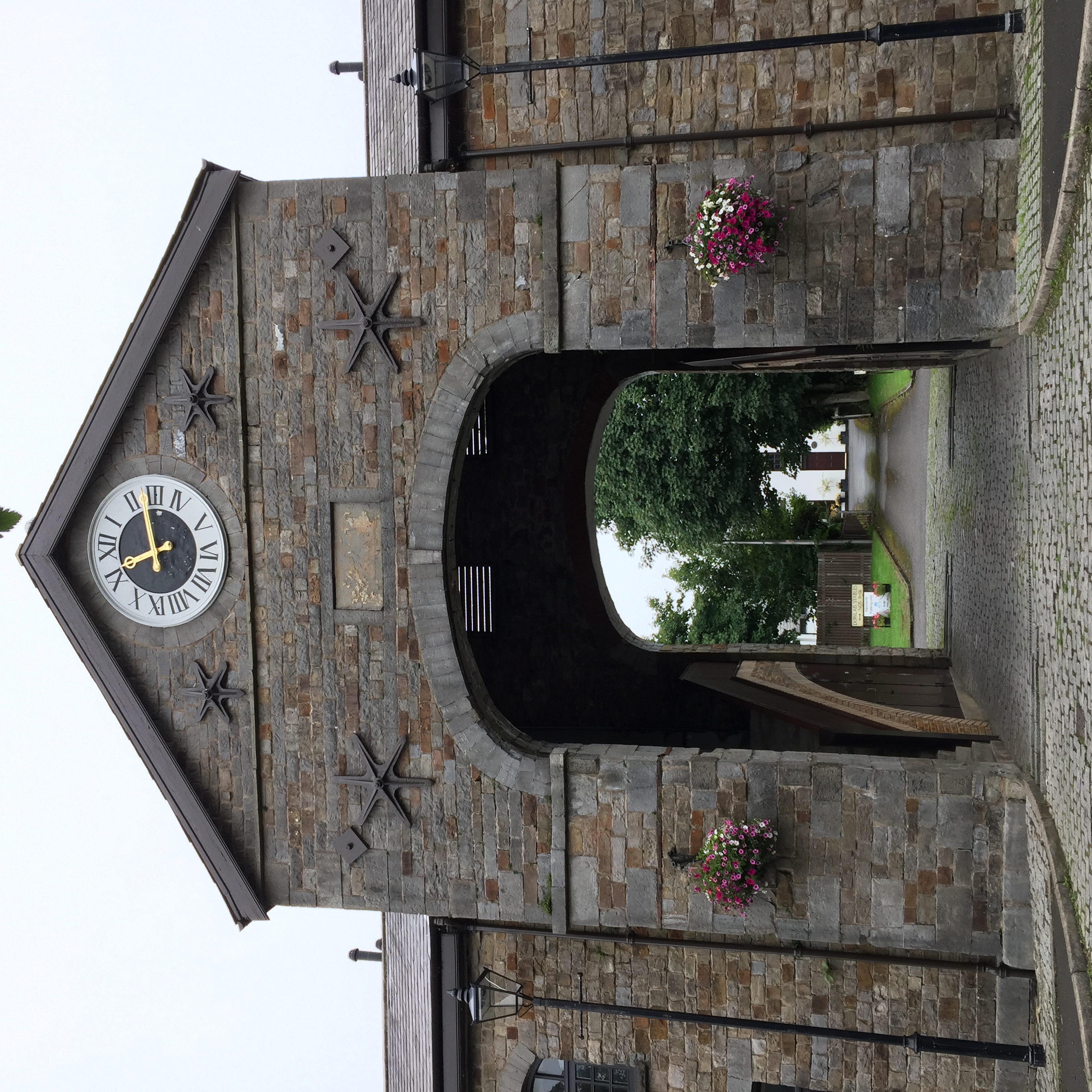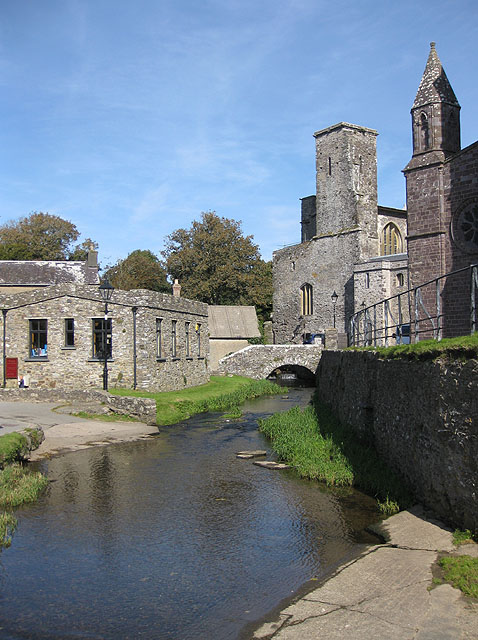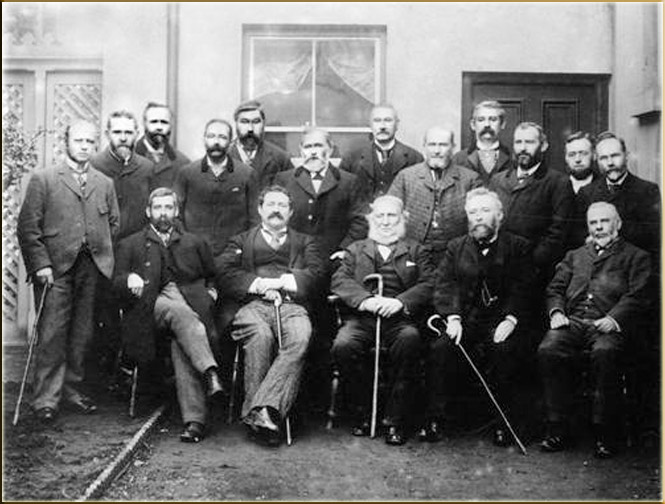|
Benjamin Evans (Baptist Minister)
The Reverend Benjamin Evans (1844 - 1900) was a Welsh Baptist minister and author, who served as Secretary of the Baptist Missionary Society in the late nineteenth century. Born on 2 May 1844 in Dowlais in Glamorganshire, Evans worked as a coal miner from the age of eight. He joined the Baptist congregation at Moriah in Dowlais in 1856, and in 1868 was accepted as a student at Haverfordwest Baptist College. Ordained in 1871, his first ministry was in the city of St Davids, Pembrokeshire, relocating in 1876 to Aberdare where he became minister of Gadlys Chapel. Evans was one of several Baptist ministers serving a working-class and largely Welsh speaking population. His personal ministry was to the community living immediately adjacent to the Gadlys ironworks which had been established in 1827. Evans quickly established himself in Gadlys as a popular preacher and Eisteddfodwr. He was known, without apparent irony, as the 'Bishop of Gadlys'.During his Gadlys ministry he was sel ... [...More Info...] [...Related Items...] OR: [Wikipedia] [Google] [Baidu] |
Baptist
Baptists form a major branch of Protestantism distinguished by baptizing professing Christian believers only (believer's baptism), and doing so by complete immersion. Baptist churches also generally subscribe to the doctrines of soul competency (the responsibility and accountability of every person before God), ''sola fide'' (salvation by just faith alone), ''sola scriptura'' (scripture alone as the rule of faith and practice) and congregationalist church government. Baptists generally recognize two ordinances: baptism and communion. Diverse from their beginning, those identifying as Baptists today differ widely from one another in what they believe, how they worship, their attitudes toward other Christians, and their understanding of what is important in Christian discipleship. For example, Baptist theology may include Arminian or Calvinist beliefs with various sub-groups holding different or competing positions, while others allow for diversity in this matter within the ... [...More Info...] [...Related Items...] OR: [Wikipedia] [Google] [Baidu] |
Baptist Missionary Society
BMS World Mission is a Mission (Christian), Christian missionary society founded by Baptists from England in 1792. It was originally called the Particular Baptist Society for the Propagation of the Gospel Amongst the Heathen, but for most of its life was known as the Baptist Missionary Society. The headquarters is in Didcot, England. History The BMS was formed in 1792 at a meeting in Kettering, England, where twelve Particular Baptist ministers signed an agreement. They were; Thomas Blundel, Joshua Burton, John Eayres, Andrew Fuller, Abraham Greenwood, William Heighton, Reynold Hogg, Samuel Pearce, John Ryland, Edward Sherman, John Sutcliff, Joseph Timms. William Staughton, present at the meeting, did not sign since he was not a minister. The first missionaries, William Carey (missionary), William Carey and John Thomas, were sent to Bengal, India in 1793. [...More Info...] [...Related Items...] OR: [Wikipedia] [Google] [Baidu] |
Dowlais
Dowlais () is a village and community of the county borough of Merthyr Tydfil, in Wales. At the 2011 census the electoral ward had a population of 6,926, The population of the Community being 4,270 at the 2011 census having excluded Pant. Dowlais is notable within Wales and Britain for its historic association with ironworking; once employing, through the Dowlais Iron Company, roughly 5,000 people, the works being the largest in the world at one stage. Name The name is derived from the Welsh ''du'' meaning 'black' and ''glais'' meaning 'stream'. History Dowlais came to prominence in the 18th and 19th centuries because of its iron and steelworks. By the mid-1840s there were between 5000 and 7000 men, women and children employed in the Dowlais works. During the early to mid 1800s the ironworks were operated by Sir John Josiah Guest and (from 1833) his wife Lady Charlotte Guest. Charlotte Guest introduced welfare schemes for the ironworkers. She provided for a church and a libra ... [...More Info...] [...Related Items...] OR: [Wikipedia] [Google] [Baidu] |
Glamorganshire
, HQ = Cardiff , Government = Glamorgan County Council (1889–1974) , Origin= , Code = GLA , CodeName = Chapman code , Replace = * West Glamorgan * Mid Glamorgan * South Glamorgan , Motto = ("He who suffered, conquered") , Image = Flag adopted in 2013 , Map = , Arms = , PopulationFirst = 326,254 , PopulationFirstYear = 1861 , AreaFirst = , AreaFirstYear = 1861 , DensityFirst = 0.7/acre , DensityFirstYear = 1861 , PopulationSecond = 1,120,910Vision of Britain �Glamorgan population , PopulationSecondYear = 1911 , AreaSecond = , AreaSecondYear = 1911 , DensitySecond ... [...More Info...] [...Related Items...] OR: [Wikipedia] [Google] [Baidu] |
St Davids
St Davids or St David's ( cy, Tyddewi, , "David's house”) is a city and a community (named St Davids and the Cathedral Close) with a cathedral in Pembrokeshire, Wales, lying on the River Alun. It is the resting place of Saint David, Wales's patron saint, and named after him. St Davids is the United Kingdom's smallest city in population (just over 1,600 in 2011) and urban area (the smallest city by local authority boundary area being the City of London). St Davids was given city status in the 12th century. This does not derive automatically from criteria, but in England and Wales it was traditionally given to cathedral towns under practices laid down in the early 1540s, when Henry VIII founded dioceses. City status was lost in 1886, but restored in 1994 at the request of Queen Elizabeth II. History Early history Although the surrounding landscape is home to a number of Palaeolithic, Bronze Age and Iron Age sites, archaeological evidence suggests that Pembrokeshire wa ... [...More Info...] [...Related Items...] OR: [Wikipedia] [Google] [Baidu] |
Pembrokeshire
Pembrokeshire ( ; cy, Sir Benfro ) is a Local government in Wales#Principal areas, county in the South West Wales, south-west of Wales. It is bordered by Carmarthenshire to the east, Ceredigion to the northeast, and the rest by sea. The county is home to Pembrokeshire Coast National Park. The Park occupies more than a third of the area of the county and includes the Preseli Hills in the north as well as the Pembrokeshire Coast Path. Historically, mining and fishing were important activities, while industry nowadays is focused on agriculture (86 per cent of land use), oil and gas, and tourism; Pembrokeshire's beaches have won many awards. The county has a diverse geography with a wide range of geological features, habitats and wildlife. Its prehistory and modern history have been extensively studied, from tribal occupation, through Roman times, to Welsh, Irish, Norman, English, Scandinavian and Flemish influences. Pembrokeshire County Council's headquarters are in the county ... [...More Info...] [...Related Items...] OR: [Wikipedia] [Google] [Baidu] |
Aberdare
Aberdare ( ; cy, Aberdâr) is a town in the Cynon Valley area of Rhondda Cynon Taf, Wales, at the confluence of the Rivers Dare (Dâr) and Cynon. Aberdare has a population of 39,550 (mid-2017 estimate). Aberdare is south-west of Merthyr Tydfil, north-west of Cardiff and east-north-east of Swansea. During the 19th century it became a thriving industrial settlement, which was also notable for the vitality of its cultural life and as an important publishing centre. Etymology The name ''Aberdare'' means "mouth/confluence of the river dare", as the town is located where the Dare river ( cy, Afon Dâr) meets the Cynon ( cy, afon Cynon). While the town's Welsh spelling uses formal conventions, the English spelling of the name reflects the town's pronunciation in the local Gwenhwyseg dialect of South East Wales. ''Dâr'' is an archaic Welsh word for oaks (the plural of ''derwen''), and the valley was noted for its large and fine oaks as late as the nineteenth century. In ancien ... [...More Info...] [...Related Items...] OR: [Wikipedia] [Google] [Baidu] |
Gadlys Chapel, Aberdare
Gadlys Chapel was a Baptist chapel in Railway Street, Gadlys, Aberdare, Wales. It was built as a branch church of Calfaria Chapel in Aberdare. History The cause of its formation began in 1858. It began as a Sunday school held in various houses until a schoolroom was built and opened on 6 February 1859. 49 members were released from Calfaria, Aberdare to form a new chapel at Gadlys. It was built in 1864 on a land leased from Dr. J.L. Roberts of Gadlys Uchaf Estate. The architect of the building was Thomas Joseph and the building cost were £675. Its first baptism took place on 5 April 1863. Benjamin Evans at Gadlys He was the church's minister from 1876 until his death in 1900. he is also known as the 'Bishop of Gadlys'. Twentieth Century The history of Gadlys in the twentieth century was characterized by a series of comparatively brief ministries, none of which lasted for more than ten years. Myles Griffiths from Bangor College, but a native of Neath was inducted as minister ... [...More Info...] [...Related Items...] OR: [Wikipedia] [Google] [Baidu] |
Aberdare Boys' Grammar School
Aberdare ( ; cy, Aberdâr) is a town in the Cynon Valley area of Rhondda Cynon Taf, Wales, at the confluence of the Rivers Dare (Dâr) and River Cynon, Cynon. Aberdare has a population of 39,550 (mid-2017 estimate). Aberdare is south-west of Merthyr Tydfil, north-west of Cardiff and east-north-east of Swansea. During the 19th century it became a thriving industrial settlement, which was also notable for the vitality of its cultural life and as an important publishing centre. Etymology The name ''Aberdare'' means "mouth/confluence of the river dare", as the town is located where the Dare river ( cy, Afon Dâr) meets the river Cynon, Cynon ( cy, afon Cynon). While the town's Welsh spelling uses formal conventions, the English spelling of the name reflects the town's pronunciation in the local Gwenhwyseg dialect of South East Wales. ''Dâr'' is an archaic Welsh word for oaks (the plural of ''derwen''), and the valley was noted for its large and fine oaks as late as the nineteen ... [...More Info...] [...Related Items...] OR: [Wikipedia] [Google] [Baidu] |
Aberdare Urban District Council
Aberdare Urban District Council was a local authority in Aberdare, Wales. History It was created in 1894 as a result of the 1894 Local Government of England and Wales Act and the 1894 Aberdare Urban District Council election saw the election of the first members of the authority. The Council existed until 1973 and replaced the Aberdare Local Board of Health which had functioned since the 1840s. Its boundaries were identical to those of the original parish of Aberdare. Initially, the Council had fifteen members but this was increased to twenty in 1906, as a result of the increase in population. There were five wards, namely Aberaman (also known as No. 5 Ward), Blaengwawr (also known as No. 4 Ward), Gadlys (also known as No. 2 Ward), Llwydcoed (also known as No. 1 Ward), and the Town Ward (also known as No. 3 Ward). The first councillors were elected at the 1894 elections. Most of the first members of the authority had served on the Local Board, including the first chairman ... [...More Info...] [...Related Items...] OR: [Wikipedia] [Google] [Baidu] |
19th-century Welsh Baptist Ministers
The 19th (nineteenth) century began on 1 January 1801 ( MDCCCI), and ended on 31 December 1900 ( MCM). The 19th century was the ninth century of the 2nd millennium. The 19th century was characterized by vast social upheaval. Slavery was abolished in much of Europe and the Americas. The First Industrial Revolution, though it began in the late 18th century, expanding beyond its British homeland for the first time during this century, particularly remaking the economies and societies of the Low Countries, the Rhineland, Northern Italy, and the Northeastern United States. A few decades later, the Second Industrial Revolution led to ever more massive urbanization and much higher levels of productivity, profit, and prosperity, a pattern that continued into the 20th century. The Islamic gunpowder empires fell into decline and European imperialism brought much of South Asia, Southeast Asia, and almost all of Africa under colonial rule. It was also marked by the collapse of the large S ... [...More Info...] [...Related Items...] OR: [Wikipedia] [Google] [Baidu] |
People From Aberdare
A person ( : people) is a being that has certain capacities or attributes such as reason, morality, consciousness or self-consciousness, and being a part of a culturally established form of social relations such as kinship, ownership of property, or legal responsibility. The defining features of personhood and, consequently, what makes a person count as a person, differ widely among cultures and contexts. In addition to the question of personhood, of what makes a being count as a person to begin with, there are further questions about personal identity and self: both about what makes any particular person that particular person instead of another, and about what makes a person at one time the same person as they were or will be at another time despite any intervening changes. The plural form " people" is often used to refer to an entire nation or ethnic group (as in "a people"), and this was the original meaning of the word; it subsequently acquired its use as a plural f ... [...More Info...] [...Related Items...] OR: [Wikipedia] [Google] [Baidu] |







_1938.jpg)